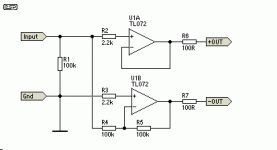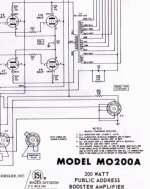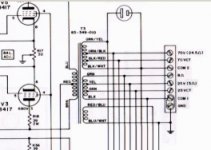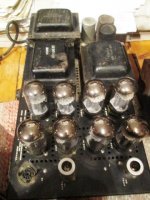Hi,
Can I put a stereo signal into a tube power amp and parallel both channel's outputs into a single speaker? Amp I'm considering doing this with at the moment is a Magnavox 9303. OPT have 4 ohm taps, speaker is 8 ohm. I'm pretty sure I could do this if both channels were amplifying the same signal but am wondering if having dissimilar signals in each channel would present a problem. I could sum them before going in but if I can get away without it then I will.
Thanks,
Michael
PS- Yes I asked a very similar question about a solid state amp in the SS forum.
Can I put a stereo signal into a tube power amp and parallel both channel's outputs into a single speaker? Amp I'm considering doing this with at the moment is a Magnavox 9303. OPT have 4 ohm taps, speaker is 8 ohm. I'm pretty sure I could do this if both channels were amplifying the same signal but am wondering if having dissimilar signals in each channel would present a problem. I could sum them before going in but if I can get away without it then I will.
Thanks,
Michael
PS- Yes I asked a very similar question about a solid state amp in the SS forum.
The usual way of bridging is inverting one input channel and connecting the - on secondary together. connecting speakers to the positive speaker conection one channel inverted now acting as -
Putting two channels in paralell isn´t a good idea if the signal is a little out of "phase" it will work against each other.
Putting two channels in paralell isn´t a good idea if the signal is a little out of "phase" it will work against each other.
Depends on output impedance. If low, due to NFB, then you would need some series resistance in each output to reduce the amount of one driving the other. If it already has a high output impedance then no need to add any resistance.
Note that putting an 8ohm speaker on two paralleled 4ohm outputs is daft. You should use bridged mode as suggested in post 2.
Note that putting an 8ohm speaker on two paralleled 4ohm outputs is daft. You should use bridged mode as suggested in post 2.
OK, lets say I sum the signals before input then bridge the amp (no parallel it). But in order to properly bridge the amp I have to invert on side.
FWIW, I tried "naive" paralleling for just a few seconds and there was no smoke but I don't want to tempt fate. I have some some references that suggest it might be alright but I would like to understand why or why not it is or isn't OK.
FWIW, I tried "naive" paralleling for just a few seconds and there was no smoke but I don't want to tempt fate. I have some some references that suggest it might be alright but I would like to understand why or why not it is or isn't OK.
here is a simple bridge adapter.
I do not see your logic in wanting to bridge the amplifier. Properly mono summed it will provide for your needs without the hassles of bridge operation.
In bridge mode the power increases but also so does distortion and wear and tear on parts. My suggestion is mono it on one channel and leave the other channel alone.
I do not see your logic in wanting to bridge the amplifier. Properly mono summed it will provide for your needs without the hassles of bridge operation.
In bridge mode the power increases but also so does distortion and wear and tear on parts. My suggestion is mono it on one channel and leave the other channel alone.
Attachments
No you can not do this! The different signals from the stereo inputs will cause the linked outputs to see a very low impedance load, which would probably damage the stereo amp.Hi,
Can I put a stereo signal into a tube power amp and parallel both channel's outputs into a single speaker?
Best way to get optimum power for your mono 8 ohm speaker is to sum the 2 stereo signals to mono, then invert one signal and run the amp in bridge with the 4 ohm taps.
if i were to parallel 2 stereo channels into one to match two 4ohm subs wired together(in a fullrange 3-way cabinet) down to 2ohms, using this amplifier module from 41hz.com 41Hz Audio:AMP9-BASIC which can easily take that load when paralleled, does this make my output mono? or should i use two right or two left channels to do this?
Cant paralell the outputs of a TRIPATH chip Anyway...
Not without the Proper DC Offset Servo, like Tripath developed for the old 2020 chip. and not implemented on that board!
Doing so will cause excess heating of the Tripath Chip, and eventual destruction.
--Been there, Done That!
Not without the Proper DC Offset Servo, like Tripath developed for the old 2020 chip. and not implemented on that board!
Doing so will cause excess heating of the Tripath Chip, and eventual destruction.
--Been there, Done That!
If the amp has output transformers, and you can un-ground the secondary of one channel, you can put the 4-ohm outputs in series (not parallel). Two 4-ohm outputs in series make an 8-ohm output.
You can only do this with secondaries that can be floated, i.e. they are not used for negative feedback. Usually, that means SETs - no pentodes and no global feedback.
You can only do this with secondaries that can be floated, i.e. they are not used for negative feedback. Usually, that means SETs - no pentodes and no global feedback.
Hi,
Can I put a stereo signal into a tube power amp and parallel both channel's outputs into a single speaker?
Yes of course you can.
IGNORE what other people say.
(why don't they know this stuff?)
That is exactly what Bogen did with their MO200, which is a dual 100W amp on one chassis.
All secondaries are connected in parallel.
Look it up.
Here is the critical detail.
In which case all the 16ohm taps become 8, and 8ohm become 4. (if you have them)
For various reasons you can't successfully run PP valve amps in bridge mode.
I will do the same with my new stereo PPP 50W amp in order to be able to run it as a 100W guitar amp when needed.
It becomes like ONE single channel amp with 2 quads of output valves in that case (8).
Attachments
Last edited:
Single input but with 2 phono inputs paralleled.
They go to 2 seperate AF amp and driver stages, then 2 seperate amp channels and 2 seperate output transformers which are then paralleled.
The thing knocks out a guaranteed 200W RMS no problems at all. although not quite down to the claimed 8hz from the factory originally.
Once modified it's a distortion free 220W RMS, but of course most people prefer (like me) to seperate the 2 channels and turn it into one almighty great kick-A 100W per channel amp.
They are starting to get rare and expensive suddenly even in OEM PA shape.
It's the most compact 200W industrial valve amp ever made, & was used to power shaker tables.
The compactness of course make it a pretty big nightmare to work on, but we do manage it (eventually!).
I reckon it's one of the best classic amps of the 60s, easily outshining anything from Mac, Dynaco, and right up there with the "magic" sound beasties you can't find anywhere today.
(We tested it in a shop, back to back against "the best" and there is nothing like it in the "hi end" production that matches it)
They go to 2 seperate AF amp and driver stages, then 2 seperate amp channels and 2 seperate output transformers which are then paralleled.
The thing knocks out a guaranteed 200W RMS no problems at all. although not quite down to the claimed 8hz from the factory originally.
Once modified it's a distortion free 220W RMS, but of course most people prefer (like me) to seperate the 2 channels and turn it into one almighty great kick-A 100W per channel amp.
They are starting to get rare and expensive suddenly even in OEM PA shape.
It's the most compact 200W industrial valve amp ever made, & was used to power shaker tables.
The compactness of course make it a pretty big nightmare to work on, but we do manage it (eventually!).
I reckon it's one of the best classic amps of the 60s, easily outshining anything from Mac, Dynaco, and right up there with the "magic" sound beasties you can't find anywhere today.
(We tested it in a shop, back to back against "the best" and there is nothing like it in the "hi end" production that matches it)
Yes of course you can.
IGNORE what other people say.
(why don't they know this stuff?)
That is exactly what Bogen did with their MO200, which is a dual 100W amp on one chassis.
All secondaries are connected in parallel.
.
Well, the Bogen 200 is a dual mono amp, so both channels get the same signal.
But the OP wants to input different signals (stereo) to the two channels and then parallel the outputs.
Doesn't that make a difference ?
Single input ...
As I clearly said, the MO200 has TWO inputs....
- Status
- This old topic is closed. If you want to reopen this topic, contact a moderator using the "Report Post" button.
- Home
- Amplifiers
- Tubes / Valves
- Stereo to mono by paralleling outputs?



